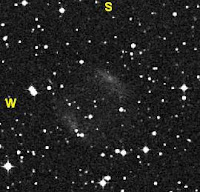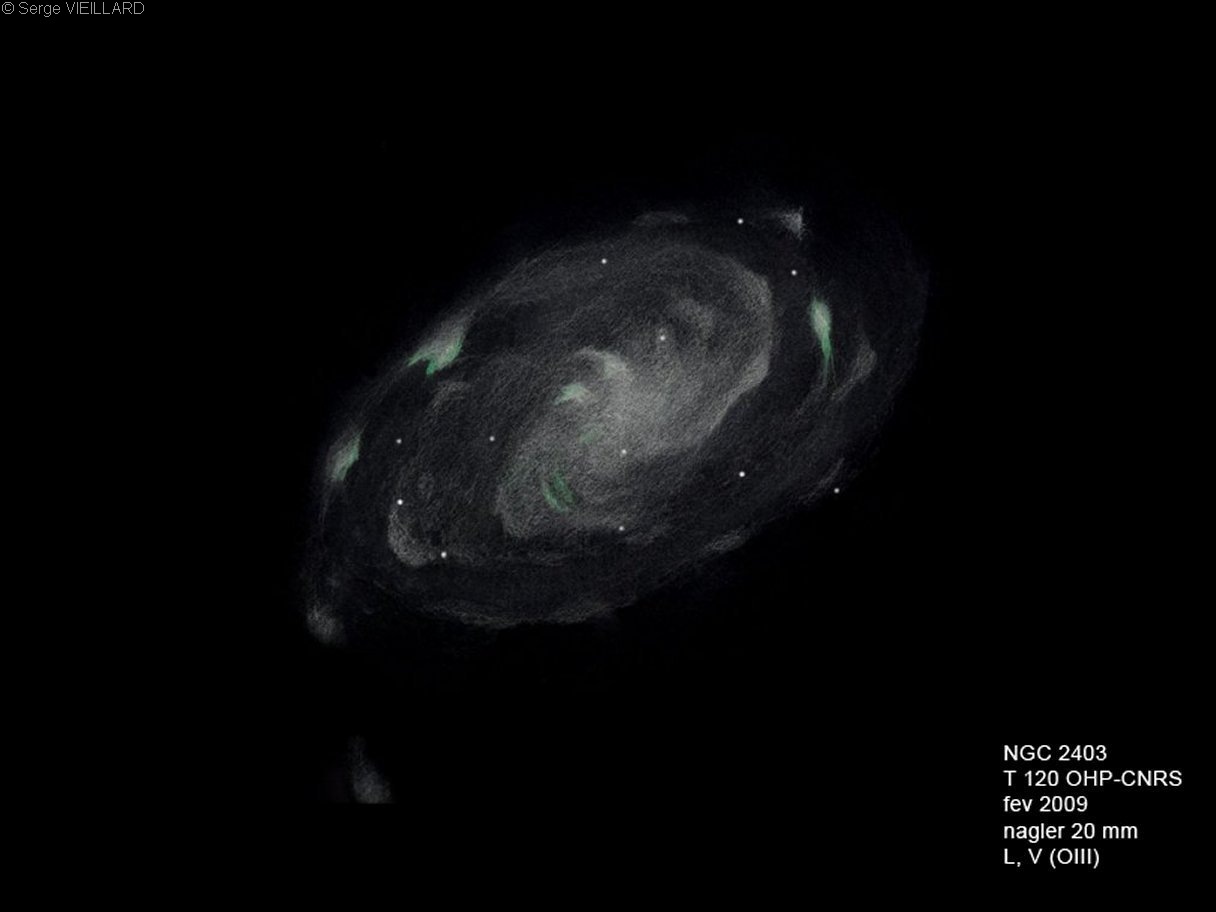Getting out twice in a week, observing, is a rarity. Having had modest success at Dinosaur Point on Saturday night, when the weather forecast showed a good opportunity on Tuesday, four TACos jumped on it and met at Willow Springs. The rationale was simple. One, it could rain for the next two months. Two, the satellite imagery was favorable, even though skies at 3:30 p.m. were mucky and not encouraging. I had a running conversation with Richard Navarrete during the afternoon, and it came down to this simple statement: "I'd hate to go and get skunked, but I'd hate worse not going and hearing it was a good night".
Our arrival was after dark, but within 45 minutes, including some equipment repair (Richard's equatorial platform battery was dead), we were underway.
I have to say, the drive to Willow in the dark is a different animal than I'm accustomed to dealing with. Driving south through Gilroy, then Hollister, is typical night "city" driving. But once I passed through the hamlet of Tres Pinos, it felt like I was on a road to nowhere. Twists, turns, occasional oncoming headlights... it was as if the road was a ribbon of safety and nothing else existed. I listened to an astronomy podcast about advanced civilizations, and learned about theorized Dyson Spheres, as I arrived.
Things worked out quite well. There was dewing, but it was minimal. The sky cleared, I was hearing SQM reading in the mid 21's. Decent transparency... not the best, but workable. I think the highlights of the night were seeing Greg LaFlamme again, before his departure to Arizona, enjoying some of Marko Johnston's humor, watching our host Kevin Ritschel buzz around toying with a 12" Synta driven Dob, and looking at views of some tough Hickson Clusters of Galaxies with Richard. Greg had one of the bet views of The Ghost Of Jupiter in his scope I've ever seen. I need more power! Also, and this is always one of the most mesmerizing things to look at when you get a great view, M51 was stunning. A view like that is what makes people look in wonder, realizing what they are seeing is real, and mindlessly far away, even though it is a "close" object. Mind numbing, mind expanding...
I suppose we were at it until about 2 a.m., when I laid down in my sleeping bag, and watched as, "overhead, without any fuss, the stars were going out."


We were all glad to have had the opportunity to observe, and enjoy each others comradarie and company.
back to the daily routine, and life on planet earth.

All above shots are done via iPhone. Wish I could say the same for those below!
Here are my observing notes...
Equipment was an 18" f/4.5 undriven Dobsonian, and three Nagler eyepieces, 20mm, 12mm and 7mm, Rigel Quickfinder, and The Sky planetarium software (as a chart). The only filter I used was an NPB.
 N 2541 Lyn GX 6.3x3.2 11.8 08 14 40 +49 03 43
N 2541 Lyn GX 6.3x3.2 11.8 08 14 40 +49 03 4320mm 18" - large, elongated 4x2 NW/SE, no core, gradually brightening to the center.
 Arp 6 GX 1.7'x1.5' 12.3 08 13 14 +45 59 00 NGC 2537
Arp 6 GX 1.7'x1.5' 12.3 08 13 14 +45 59 00 NGC 253712mm 18" - small, mostly round with slight elongation NW/SE, bright, no discernible core, bright throughout. IC2233 in same field, with 7mm long dim slash 6x1 N/S with star embedded in N end.
 N 2493 Lyn GX 1.9x1.9 12 08 00 23 +39 49 49
N 2493 Lyn GX 1.9x1.9 12 08 00 23 +39 49 497mm - 18" - small, very bright core with stellar nucleus, dimmer outer halo extended 3x2 SW/NE. N2495 and CGCG 207-17 both visible to NE.
 Arp 143 GX 1.2'x0.8' 13.2 07 46 53 +39 01 00 NGC 2444 and NGC 2445
Arp 143 GX 1.2'x0.8' 13.2 07 46 53 +39 01 00 NGC 2444 and NGC 24457mm - 18" - almost identical galaxies, N/S, dim halos each with bright stellar cores. Galaxy to N is a bit brighter. Both small in angular size.
 NGC 2419 Lyx GC 1.7 11.5 07 38 60 +38 53 00
NGC 2419 Lyx GC 1.7 11.5 07 38 60 +38 53 007mm - 18" - mottled but bright globular, averted gives hints of resolution. This object is the farthest globular cluster from us, in our own galaxy.
 N 2415 Lyn GX 0.9x0.9 12.4 07 36 56 +35 14 32
N 2415 Lyn GX 0.9x0.9 12.4 07 36 56 +35 14 327mm 18" - small round galaxy with moderately bright core, no nucleus, dim halo.
 N2373/75/79 Gem Trio 10.1 13.7:13.6:13.5 07 27 24 +33 48 00
N2373/75/79 Gem Trio 10.1 13.7:13.6:13.5 07 27 24 +33 48 007mm 18" - all three show with averted vision. Pair are mostly N/S, took work before they started to show.
 N2385/88/89 Gem Trio 7.7 14.2:13.7:12.9 07 29 06 +33 48 00
N2385/88/89 Gem Trio 7.7 14.2:13.7:12.9 07 29 06 +33 48 0020mm 18" - all three show up easily. 7mm shows all three have stellar nuclei, and appear elongated N/S.
 NGC 2372 NGC 2371 Gem PN 47x43 9.5 07 25 36 +29 30 00
NGC 2372 NGC 2371 Gem PN 47x43 9.5 07 25 36 +29 30 007mm 18" - nice bi-lobed proto-planetary with pinpoint progenitor star obvious. Both lobes bright, W lobe is brighter and more condensed, E lobe appears larger but dimmer. E lobe aslo has bright condensed center. Appears there is a larger dim oval envelope surrounding entire object. W lobe has a blue-green tint, without filters.
 Arp 82 GX 2.5'x1.2' 12.8 08 11 13 +25 12 00 NGC 2535 NGC 2536
Arp 82 GX 2.5'x1.2' 12.8 08 11 13 +25 12 00 NGC 2535 NGC 253612mm 18" - dimmer member of pair is SE of larger and brighter one. Larger member appears elongated N/S, dimmer has tiny stellar core and is perhaps linear inside envelope.
 NGC 2420 Gem OC 7 10.2 07 38 24 +21 34 00
NGC 2420 Gem OC 7 10.2 07 38 24 +21 34 0012mm 18" - horseshoe of bright stars opening to W, with a tail of stars off the SE end of the closed part of the horseshoe. About 8 stars in the horseshoe, with 4 in the arced tail, opening to the W. Many dim stars fill in and through the brighter components. Very obvious cluster, elongated E/W. CGCG 1117-59 and 60 show up barely as dim elongated smudges with 7mm.
 NGC 2392 Gem PN 47x43 9.35 07 29 12 +20 55 00
NGC 2392 Gem PN 47x43 9.35 07 29 12 +20 55 007mm 18" - bright pinpoint central star is surrounded by a very tight black ring, with a brightish second ring that is mottled and elongated slightly N/S. Outside is a large dimmer ring that is uneven in brightness, perhaps just some mottling. Good view. No color. Photo credit NASA
 Arp 165 GX 1.8' 12.2 07 36 37 +17 53 00 NGC 2418
Arp 165 GX 1.8' 12.2 07 36 37 +17 53 00 NGC 24187mm 18'" - very small with a condensed core, stellar nucleus, elongation seems to vary with averted vision, NW/SE, but changes, so may be disrupted.
 Abell 21 Gem PN 744"x509" 10.2 07 29 02 +13 15 13 PK 205+14.1 = PN G205.1+14.2 = YM 29 = Sh 2-274 = Medusa Nebula
Abell 21 Gem PN 744"x509" 10.2 07 29 02 +13 15 13 PK 205+14.1 = PN G205.1+14.2 = YM 29 = Sh 2-274 = Medusa Nebula20mm 18" - large, dim, using NPB filter. 12mm - elongated NNW/SSE and mottled, almost a dark ring inside the border, with an uneven edge to the entire outer area. Easy target. Photo credit NASA
 N2510/11/13 CMi Trio 5.6 13.4:14.1:11.6 08 02 30 +09 24 00
N2510/11/13 CMi Trio 5.6 13.4:14.1:11.6 08 02 30 +09 24 007mm 18" - NGCs all show, although sky is not good in this direction. 2513 is faint but obvious, other pair are very faint indistinct small smudges.
All four of the next targets are unconfirmed, although the first is pretty assured. I include them only as impressions, what I felt I was catching glimpses of. The mind is a funny thing when looking for threshold targets.
 Abell 24 CMi PN 265"x180" 13.9 07 51 37 +03 00 21 PK 217+14.1 = PN G217.1+14.7
Abell 24 CMi PN 265"x180" 13.9 07 51 37 +03 00 21 PK 217+14.1 = PN G217.1+14.712mm 18" - large, no filter, elongated N/S, central star dim but obvious, stars embedded throughout, but bright ones on S edge. Mottled, brighter eastern edge. Photo credit Martin Germano
 Abell 22 CMi PN 105"x68" 07 36 07 +02 42 28 PK 215+11.1 = K 1-11 = PN G215.6+11.1
Abell 22 CMi PN 105"x68" 07 36 07 +02 42 28 PK 215+11.1 = K 1-11 = PN G215.6+11.112mm 18" - NPB, large oval elongated NNE/SSW, very indistinct, perhaps a bit of brightening on NE and E edge. Hint of annularity. Photo credit Stathis Kafalis
 Abell 20 CMi PN 65" 14.7 07 22 57 +01 45 37 PK 214+7.1 = PN G214.9+07.8
Abell 20 CMi PN 65" 14.7 07 22 57 +01 45 37 PK 214+7.1 = PN G214.9+07.812mm 18" - NPB, medium sized and very dim, round with possible N/S slight elongation, even brightness across object, maybe central star with other stars involved on N and S edges - inside edges. Photo credit Stathis Kafalis
 Abell 25 Mon PN 150"x145" 08 06 46 -02 52 35 PK 224+15.1 = K 1-13 = PN G224.3+15.3
Abell 25 Mon PN 150"x145" 08 06 46 -02 52 35 PK 224+15.1 = K 1-13 = PN G224.3+15.312mm 18" - NPB, elongated a bit N/S, even brightness across, central star, sharp edge especially along NE edge or along entire E side. Star is either central,or on N edge, hard to tell. Photo credit Stathis Kafalis
 M048 HYD OC 54 5.5 08 13 48 -05 48 00 NGC 2548
M048 HYD OC 54 5.5 08 13 48 -05 48 00 NGC 254820mm 18" - large, bright, coarse, dispersed. Lots of chains.






















